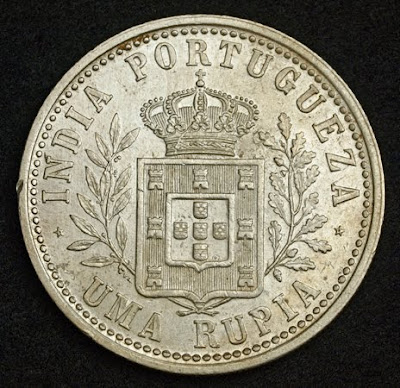 |
| Portuguese India coins One Rupee silver coin of 1903, King Carlos I of Portugal. |
 |
| Índia Portuguesa Uma Rupia |
Portuguese Indian rupia, Coins of Portuguese India, Portuguese India silver coin, Coins of the Portuguese India, Portuguese India colonial coinage, Portuguese India silver coins, Numismatic Collection, silver coins, old coins, coin collecting, rare coins, world coins, foreign coins, heritage coins, silver ira investment, silver bullion coins, silver coin collection investors, investment coins, antique coins, Unique Silver Coins, collectible coins.
Obverse: Head of Carlos of Portugal right.
Legend: CARLOS I REI DE PORTUGAL * 1903 *
Reverse: Crowned coat-of-arms of the Portugueze Empire, flanked by oak and olive sprays.
Legend: INDIA PORTUGUEZA * UMA RUPIA *
Reference: KM-17.
Mintage: 200,000 pcs.
Denomination: UMA RUPIA (ONE RUPEE)
Weight: 11.54 gram of Silver (.917); Diameter: 30 mm.
Portuguese Indian rupia
The rupia was the currency of Portuguese India until 1958.Before 1871, the rupia was subdivided into 750 bazarucos, 600 réis (singular: real), 20 pardaus or 10 tangas, with the xerafim worth 2 rupias. After 1871, 960 réis or 16 tangas (worth 60 réis) equalled 1 rupia. The rupia was equal in value to the Indian rupee. This meant the tanga was equal in value to the Indian anna. In 1958, the currency was replaced by the escudo at the rate of 1 rupia = 6 escudos.
Coins
Goa, Damão and Diu issued their own coinages until the middle of the 19th century. Damão issued copper 3, 15, 30 and 60 réis coins until 1854 when the mint closed. Diu issued lead and tin 5 and 10 bazarucos together with tin 20 bazarucos, copper 30 and 60 réis and silver 150 and 300 réis and 1 rupia. The Diu mint closed in 1859.
Goa issued the most diverse coinage of the three mints. In addition to tin bastardo, there were copper coins in denominations of 3, 4½, 6, 7½, 9, 10, 12 and 15 réis, ½ and 1 tanga, silver coins for ½ and 1 tanga, ½ and 1 pardau, and 1 rupia, and gold 1, 2, 4, 8 and 12 xerafins. The Goa mint was closed by the British in 1869.
Following the closure of the last local mint, coins were imported from Portugal beginning in 1871. This new coinage coincided with the reform of the subdivisions of the rupia. Copper coins were introduced in denominations of 3, 5, 10 and 15 réis, ½ and 1 tanga. In 1881, copper ⅛ tanga and silver ⅛, ¼, ½ and 1 rupia coins were introduced. Bronze replaced copper in 1901, whilst cupro-nickel 2 and 4 tangas were introduced in 1934, followed by ½ and 1 rupia in 1947 and 1952, respectively.
Banknotes
The first paper money issued specifically for Portuguese India was issued by the Junta da Fazenda Pública in 1882 in denominations of 10 and 20 rupias. These were followed in 1883 by notes issued by the General Government (Governo Geral) for 5, 10, 20, 50, 100 and 500 rupias.
In 1906, the Banco Nacional Ultramarino took over the issuance of paper money, issuing notes for 5, 10, 20 and 50 rupias. In 1917, notes were added for 4 and 8 tangas, 1 and 2½ rupias. These were the only issue of tanga denominated notes, whilst the 2½ rupia notes were issued until 1924 and the 1 rupia until 1929. 100 and 500 rupias notes were reintroduced in 1924.